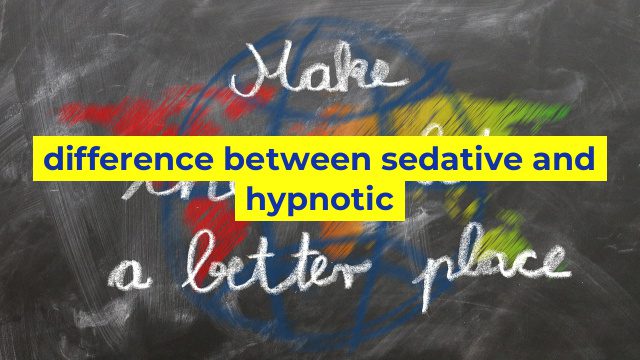The Difference Between Sedative and Hypnotic Medications
When it comes to medications that can cause drowsiness, two terms that are often used interchangeably are sedatives and hypnotics. While both types of drugs can help people sleep or reduce anxiety, they work in slightly different ways.
Sedatives
Sedatives are medications that depress the central nervous system, which can result in a calming effect. They are often prescribed to treat anxiety, panic attacks, and insomnia. Examples of sedatives include benzodiazepines (such as Xanax and Valium) and barbiturates (such as Phenobarbital).
Sedatives work by enhancing the activity of a neurotransmitter called gamma-aminobutyric acid (GABA) in the brain. This causes the brain to produce calming effects, which can help reduce anxiety and promote relaxation.
It’s important to note that sedatives can have side effects, including dizziness, confusion, and impaired motor coordination. They can also be addictive, so they should only be used as directed by a doctor.
Hypnotics
Hypnotics are medications that are specifically designed to help people fall asleep and stay asleep. They work by slowing down activity in the brain, which can help people feel drowsy and fall asleep more easily. Examples of hypnotic medications include zolpidem (Ambien), eszopiclone (Lunesta), and ramelteon (Rozerem).
Unlike sedatives, hypnotics do not have anxiolytic (anti-anxiety) effects. They are used primarily to treat sleep disorders, such as insomnia. Hypnotics are typically prescribed for short-term use, as they can also be habit-forming and may cause adverse effects such as dizziness, fatigue, and impaired coordination.
Conclusion
While both sedatives and hypnotics can cause drowsiness, they have different mechanisms of action and are used for different purposes. Sedatives are used primarily to treat anxiety and panic attacks, while hypnotics are used to treat sleep disorders. As with any medication, it’s important to use sedatives and hypnotics only as directed and to talk to a doctor if you experience any adverse effects.
Table difference between sedative and hypnotic
| Attribute | Sedative | Hypnotic |
|---|---|---|
| Definition | A drug that calms and relaxes the patient but does not induce sleep | A drug that induces a state of sleep in the patient |
| Effects on the CNS | Depresses CNS activity | Produces CNS depression leading to sleep |
| Dosage | Lower than hypnotic doses | Higher than sedative doses |
| Duration of action | Shorter than hypnotic drugs | Longer than sedative drugs |
| Indications | Used to treat anxiety, agitation, and insomnia | Used to treat severe insomnia and some sleep disorders |
| Examples | Diazepam, Lorazepam, Alprazolam | Zolpidem, Triazolam, Zaleplon |
